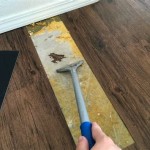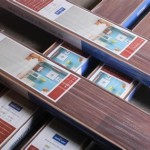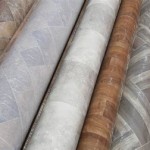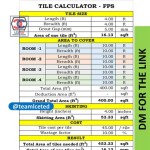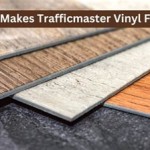14mm Thick Engineered Wood Flooring: A Comprehensive Overview
Engineered wood flooring has gained considerable popularity as a versatile and durable alternative to solid hardwood. Among the various thicknesses available, 14mm engineered wood flooring stands out as a balanced option, offering a compelling combination of structural integrity, aesthetic appeal, and cost-effectiveness. This article provides a detailed examination of 14mm engineered wood flooring, exploring its construction, benefits, applications, installation considerations, and maintenance requirements.
Engineered wood flooring, unlike solid hardwood, comprises multiple layers bonded together. This construction method enhances dimensional stability, making it less susceptible to warping, cupping, or expanding and contracting due to fluctuations in humidity and temperature. A typical engineered wood plank consists of a top layer (wear layer) of real hardwood, adhered to a core consisting of multiple layers of plywood, high-density fiberboard (HDF), or softwood. The 14mm designation refers to the total thickness of the plank, encompassing both the wear layer and the core.
The wear layer, typically ranging from 2mm to 6mm in 14mm flooring, determines the overall aesthetic appearance and resilience of the flooring. Thicker wear layers allow for multiple refinishing cycles, extending the lifespan of the floor. The core layers provide structural stability and resistance to moisture. The specific materials and construction of the core can influence the flooring's performance and suitability for different environments.
Key Benefits of 14mm Engineered Wood Flooring
Several advantages make 14mm engineered wood flooring a desirable choice for various residential and commercial applications.
Dimensional Stability: The multi-layered construction inherently provides greater dimensional stability compared to solid hardwood. This characteristic is particularly advantageous in environments with variable humidity levels, such as basements or kitchens. Engineered wood is less likely to warp, cup, or buckle when exposed to moisture, ensuring a longer lifespan and maintaining its aesthetic appearance.
Cost-Effectiveness: Compared to thicker engineered wood options or solid hardwood, 14mm engineered wood flooring generally presents a more cost-effective solution. The reduced material usage in the core layers contributes to lower manufacturing costs, making it an accessible option for budget-conscious projects without compromising on the visual appeal of real wood.
Versatility in Installation: 14mm engineered wood flooring can be installed using various methods, including floating, gluing, or stapling. Floating installation, where the planks are interlocked and rest on an underlayment, is a popular choice for DIY projects and offers ease of installation. Glued-down installations provide a more permanent bond and enhance stability, while stapling is suitable for wood subfloors.
Wide Range of Styles and Finishes: 14mm engineered wood flooring is available in a diverse range of wood species, colors, textures, and finishes. From classic oak and maple to exotic Brazilian cherry and walnut, homeowners and designers can select options that complement their desired aesthetic. The wear layer can be finished with various coatings, such as polyurethane, oil, or lacquer, each offering different levels of durability and sheen.
Compatibility with Underfloor Heating: Many 14mm engineered wood flooring products are compatible with underfloor heating systems. The engineered construction allows for efficient heat transfer without significant expansion or contraction, providing comfortable and energy-efficient heating. However, it is crucial to consult the manufacturer's specifications to ensure compatibility and proper installation procedures.
Applications of 14mm Engineered Wood Flooring
14mm engineered wood flooring finds applications in a wide range of settings due to its versatility and durability.
Residential Spaces: This thickness is well-suited for various residential areas, including living rooms, bedrooms, dining rooms, and hallways. Its durability and aesthetic appeal make it a popular choice for creating warm and inviting interiors. In areas with moderate foot traffic and minimal moisture exposure, 14mm engineered wood flooring provides a long-lasting and visually appealing flooring solution.
Commercial Environments: While not typically recommended for high-traffic commercial areas, 14mm engineered wood flooring can be suitable for low-to-moderate traffic commercial spaces, such as offices, boutiques, and restaurants. In these settings, it can contribute to a sophisticated and inviting atmosphere. Selecting a product with a durable wear layer and appropriate finish is essential to withstand the demands of commercial use.
Apartments and Condominiums: The sound-dampening properties of engineered wood flooring make it a suitable choice for apartments and condominiums. When installed with a proper underlayment, it can help reduce noise transmission between floors, enhancing the comfort and privacy of residents.
Renovation Projects: 14mm engineered wood flooring is often used in renovation projects due to its relatively thin profile. It can be installed over existing subfloors without significantly raising the floor height, minimizing the need for adjustments to doors and moldings.
Installation Considerations for 14mm Engineered Wood Flooring
Proper installation is crucial for ensuring the longevity and performance of 14mm engineered wood flooring. Several factors should be considered during the installation process.
Subfloor Preparation: The subfloor must be clean, level, and dry before installation. Any imperfections or irregularities in the subfloor can affect the flooring's stability and appearance. Subfloor preparation may involve leveling compounds, sanding, or the application of a moisture barrier.
Acclimation: Allowing the engineered wood flooring to acclimate to the environment for several days before installation is essential. This allows the planks to adjust to the room's temperature and humidity levels, minimizing the risk of expansion or contraction after installation. The manufacturer's instructions should be followed regarding acclimation time and conditions.
Underlayment Selection: The choice of underlayment depends on the installation method, subfloor type, and desired performance characteristics. Underlayment can provide sound insulation, moisture protection, and cushioning underfoot. It is important to select an underlayment that is compatible with the engineered wood flooring and the subfloor.
Expansion Gaps: Leaving expansion gaps around the perimeter of the room and at doorways is crucial to accommodate natural expansion and contraction. These gaps allow the flooring to move without buckling or creating pressure on walls or other fixtures. The manufacturer's instructions should be consulted regarding the appropriate size of expansion gaps.
Installation Method: The choice of installation method depends on the subfloor type, the specific engineered wood flooring product, and personal preferences. Floating installations are relatively easy to perform but may not be suitable for all situations. Glued-down installations provide a more permanent bond but require specialized adhesives and techniques. Stapling is a suitable option for wood subfloors but may not be appropriate for concrete subfloors.
Maintenance of 14mm Engineered Wood Flooring
Proper maintenance is essential for preserving the beauty and extending the lifespan of 14mm engineered wood flooring.
Regular Cleaning: Regular sweeping or vacuuming is necessary to remove dust, dirt, and debris that can scratch the surface. Using a soft-bristled brush or a vacuum cleaner with a felt attachment is recommended to avoid damaging the finish.
Damp Mopping: Damp mopping with a pH-neutral wood floor cleaner is recommended for removing spills and stains. Avoid using excessive water, as it can seep into the seams and damage the core layers. Always wring out the mop thoroughly before cleaning the floor.
Avoiding Harsh Chemicals: Harsh chemicals, abrasive cleaners, and solvent-based products should be avoided, as they can damage the finish and discolor the wood. Always test any cleaning product on an inconspicuous area of the floor before applying it to the entire surface.
Protective Measures: Using rugs or mats in high-traffic areas, such as entrances and hallways, can help protect the flooring from wear and tear. Placing felt pads under furniture legs can prevent scratches and dents. Avoiding wearing shoes with hard soles can also help minimize surface damage.
Refinishing: Depending on the thickness of the wear layer, 14mm engineered wood flooring can be refinished multiple times. Refinishing involves sanding down the existing finish and applying a new coat of polyurethane or other protective coating. Refinishing can restore the floor to its original beauty and extend its lifespan.
Key Considerations When Choosing 14mm Engineered Wood Flooring
Selecting the right 14mm engineered wood flooring requires careful consideration of several factors to ensure it meets specific needs and expectations.
Wear Layer Thickness: The thickness of the wear layer is a crucial factor influencing the flooring's durability and lifespan. Thicker wear layers allow for more refinishing cycles and provide greater resistance to scratches and wear. For high-traffic areas or homes with pets, selecting a product with a thicker wear layer is recommended.
Core Material: The core material contributes to the flooring's dimensional stability and resistance to moisture. Plywood cores are generally considered the most durable and moisture-resistant, while HDF cores offer good stability at a lower cost. Softwood cores are less expensive but may be more susceptible to moisture damage.
Finish Type: The finish type affects the flooring's appearance, durability, and maintenance requirements. Polyurethane finishes are durable and water-resistant, while oil finishes provide a natural look and feel. Lacquer finishes offer a high-gloss appearance but may be less durable than polyurethane. The desired level of sheen and maintenance requirements should be considered when selecting a finish type.
Installation Method: The chosen installation method can influence the overall cost and ease of installation. Floating installations are relatively easy to perform but may not be suitable for all situations. Glued-down installations provide a more permanent bond but require specialized adhesives and techniques. The subfloor type and personal preferences should be considered when selecting an installation method.
Manufacturer Reputation: Choosing engineered wood flooring from a reputable manufacturer is essential for ensuring quality and performance. Reputable manufacturers typically offer warranties and provide detailed specifications and installation instructions. Researching reviews and seeking recommendations from flooring professionals can help identify reliable manufacturers.

Natural Rustic 150 Wide Lacquered Engineered Wood Flooring 14mm Thick

14mm Engineered Wood Flooring Flooring365

Natural Rustic 150 Wide Uv Oiled Engineered Wood Flooring 14mm Thick

Engineered Wooden Flooring Thickness 14mm At Rs 300 Sq Ft In Delhi Id 25673215862

14mm Engineered Wood Flooring Flooring365

Natural Oak Plank Engineered Flooring 14mm Thick X L 1900 W 150 2 28m2 Pack Size The Furniture Market

Why 14mm Engineered Wood Flooring Is The Perfect Thickness And Beyond Blog

American Black Walnut Plank Timber Flooring Wooden Floor 14mm 15mm Thickness Hardwood Tiles Engineered Wood China Made In Com

Natural Oak Herringbone Engineered Flooring 14mm Thick X L 600 W 125 1 2m2 Pack Size The Furniture Market

Carpenters Choice Natural Brushed Oiled 14mm X 180mm Engineered Wood Flooring Super
Related Posts


